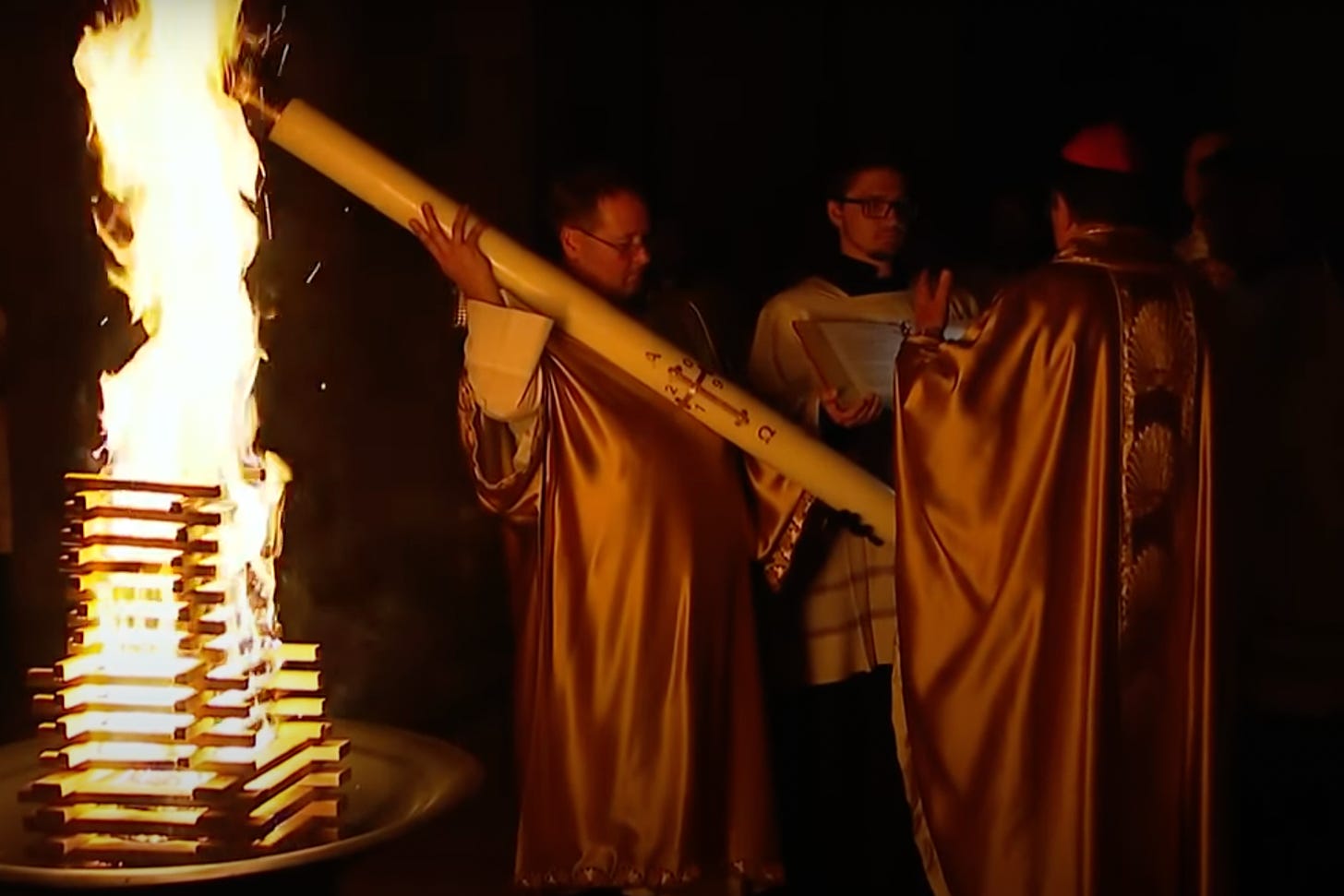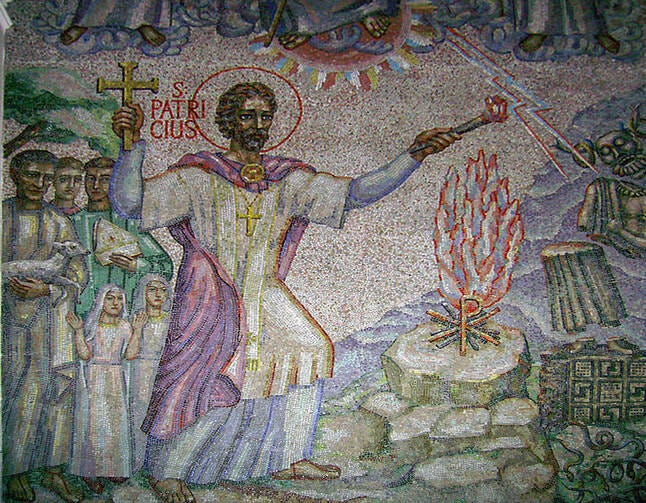
The Easter Vigil is the highest point of the Church’s entire liturgical life, the commemoration of Christ’s resurrection from the dead, in which the Church is bathed in new light, shouts “Alleluia,” and celebrates that death is defeated, and that Christ opens the door to eternal beatitude in the presence of God himself.
With all that celebrate, it’s no wonder the Easter Vigil Mass is pretty cool, and packed with symbols, customs, and rituals you don’t see every day.

But if you go to Easter Vigil, you might find yourself wondering why there’s a fire outside, or why the priest sticks pins of some kind into a tall candle. Or why a deacon (or somebody) chants a pretty long thing — and why all of that happens before the regular Mass parts even get started.
Well, here at The Pillar, we’ve got you covered.
Here’s your guide to some of the cool customs at the start of the Easter Vigil Mass:
A holy campfire - the Lucernarium
The Church instructs that a “blazing fire” should be prepared outside the church building, where the people gather for the Easter Vigil.
A blazing fire? Yeah. This Mass is cool already, huh? The blazing fire begins the Lucernarium, or “service of light.”
And actually, there is a long custom of burning fires brightly in the vigil night awaiting Easter.
In the fourth century, in the days of St. Patrick of Ireland, it was already the custom of Christians to light a bonfire ahead of the Easter celebration, to proclaim, in symbol, Jesus Christ, the light of the world.
When St. Patrick aimed to evangelize Ireland, he lit one year a bright Easter fire on a hilltop, which could be seen for miles.
The date of Easter coincided with a pagan holiday in Ireland, and Patrick’s Easter fire defied a local pagan custom, which said that no one could light a fire until the chieftain king had lit his.
So when Patrick lit his fire, emissaries came to put it out. Some were converted to Christianity. Some found they could not put out the fire. Eventually Patrick was summoned before the local chieftain king, and Patrick convinced him to allow the proclamation of the Gospel safely in his region.
The Easter fire, the story goes, spread the Gospel across Ireland.
Orthodox Christians have another Easter fire custom.
Greek Orthodox tradition says that a blue flame, the Holy Fire, rises miraculously on Holy Saturday morning in Jerusalem, from a slab covering the Holy Sepulcher, where Christ’s dead body was lain.
The Orthodox Patriarch of Jerusalem lights blessed candles from that flame, and from those candles, more candles and lamps are lit around the city, passing light from believer to believer. The Holy Fire is sent by flight from Jerusalem to other Orthodox patriarchs, in other parts of the world, as a symbol of the resurrection of Christ.
—
In Germany, it has been the custom for centuries to light large bonfires on Holy Saturday, to anticipate the coming of Christ — and similar fires are lit annually in Fredericksburg, Texas, an area settled by German farmers.
The fires in Germany can get pretty big:
When the fire is lit at Easter Vigil, it becomes the source of light for the parish — a symbol of the spreading light of Christ.
The congregation waits in darkness, holding unlit candles. The priest lights the Paschal, or Easter, Candle, and processes into the Church. With that candle, he lights the candles of the members of the congregation, as all chant:
“The Light of Christ.”
“Thanks be to God.”
Candlelight spreads across the entire church, and in many parishes, the candles remain the only lights until the Gospel is read, and the Alleluia is sung.
As Pope Emeritus Benedict XVI described it in a 2011 homily:
“First there is the fire that becomes light. As the procession makes its way through the church, shrouded in the darkness of the night, the light of the Paschal Candle becomes a wave of lights, and it speaks to us of Christ as the true morning star that never sets – the Risen Lord in whom light has conquered darkness.”
The Easter Vigil candle lighting ceremony calls to mind that the Church once regularly practiced “services of light.”
According to Fr. Michael Flynn, former director of the USCCB’s liturgy office:
“It is important to note that this portion of the Easter Vigil has not always been the only example of a ‘service of light.’ Such services were once commonplace.
Imagine how precious a candle, as the only source of light, must have been to families and monastic communities alike as the day came to an end and the sun began to set in Gaul, Spain, and other areas in the early Middle Ages. There were of course no electric street lights, no lamps available at the touch of a switch. Candles were costly, and often a single candle provided the sole source of light throughout the impenetrable darkness of the night. The importance of such a light found liturgical expression in evening lamp-lighting services called lucernaria.
In monastic communities these often served as a kind of prelude to all-night vigils, especially on important feast days. The hymn and prayer texts which accompanied the lucernaria made ready use of the solitary light – this one sign of security and hope enclosed by an otherwise dark night – as a symbol of Christ as the light to the world.
It is no wonder, then, that a most elaborate Lucernarium came to climax the opening moments of the Vigil of Easter, the most important vigil of the year.”
About that candle
In front of the blazing fire, the priest prepares the Church’s Paschal Candle, the Easter candle which symbolizes the risen Christ, and which is used in baptism liturgies throughout the year.
Often a highly decorated candle already, the priest at the Easter Vigil, in front of the Easter fire, carves a cross into the candle’s wax. He draws the Greek letters Alpha and Omega, because Christ is the beginning and the end, and he carves the year into the cross.
Then he pushes into the candle five pieces of incense (they look like pins) to symbolize the five wounds of Christ.
If you’re curious, the incense pins (they’re called nails) are usually sold with the candle. But if you lose yours, you can buy ‘em online. A set usually costs about three bucks, if you can find them — supply chain issues and all that.
As a side note, seasoned veterans advise pre drilling the holes for the pins - a high density candle is tougher than it looks, and more than one incense pin has been broken in the attempt to get it stuck in the candlewax.
While the priest pushes the nails into the candle, he prays:
“By his holy and glorious wounds, may Christ the Lord guard us and protect us. Amen.”
The priest lights the Paschal Candle from the Easter fire, before processing into the Church to spread the light of Christ.
—
It’s not clear how long Christians have been lighting a Paschal Candle.
The custom might go back to the earliest days of the Church, and to the Jewish custom of lighting a lamp at the end of the Sabbath.
The Pascal Candle was definitely in use by the middle of the fourth century, when St. Jerome mentioned it in a letter.
In the early Church, the candle was broken up into small pieces which were distributed to members of the congregation. Later it became the custom to light it until the Ascension, and then until Pentecost.
The candle is customarily made of beeswax.
And about those bees: Hæc nox est
Bees feature prominently in the Exsultet, the Easter proclamation, which is chanted at the Easter Vigil customarily by a deacon, or, if there is no deacon, by a priest or a lay cantor.
The ancient Exsultet chants the mystery of salvation, and the power of Easter. It is one of the most beautiful moments in the Church’s liturgical life.
While the form has changed over the centuries, the current text of the Exsultet has been in use for more than 1,200 years in the life of the Church.
You can listen to it in English here:
Or in Latin here:
And you can read the full text here. Don’t forget to look for the mention of the bees (Some parishes uses a slightly shortened version.):
Exult, let them exult, the hosts of heaven,
exult, let Angel ministers of God exult,
let the trumpet of salvation
sound aloud our mighty King’s triumph!Be glad, let earth be glad, as glory floods her,
ablaze with light from her eternal King,
let all corners of the earth be glad,
knowing an end to gloom and darkness.Rejoice, let Mother Church also rejoice,
arrayed with the lightning of his glory,
let this holy building shake with joy,
filled with the mighty voices of the peoples.Therefore, dearest friends,
standing in the awesome glory of this holy light,
invoke with me, I ask you,
the mercy of God almighty,
that he, who has been pleased to number me,
though unworthy, among the Levites,
may pour into me his light unshadowed,
that I may sing this candle’s perfect praises.(V. The Lord be with you.
R. And with your spirit.)
V. Lift up your hearts.
R. We lift them up to the Lord.
V. Let us give thanks to the Lord our God.
R. It is right and just.It is truly right and just,
with ardent love of mind and heart
and with devoted service of our voice,
to acclaim our God invisible, the almighty Father,
and Jesus Christ, our Lord, his Son, his Only Begotten.Who for our sake paid Adam’s debt to the eternal Father,
and, pouring out his own dear Blood,
wiped clean the record of our ancient sinfulness.These, then, are the feasts of Passover,
in which is slain the Lamb, the one true Lamb,
whose Blood anoints the doorposts of believers.This is the night,
when once you led our forebears, Israel’s children,
from slavery in Egypt
and made them pass dry-shod through the Red Sea.This is the night
that with a pillar of fire
banished the darkness of sin.This is the night
that even now, throughout the world,
sets Christian believers apart from worldly vices
and from the gloom of sin,
leading them to grace
and joining them to his holy ones.This is the night,
when Christ broke the prison-bars of death
and rose victorious from the underworld.
Our birth would have been no gain,
had we not been redeemed.O wonder of your humble care for us!
O love, O charity beyond all telling,
to ransom a slave you gave away your Son!O truly necessary sin of Adam,
destroyed completely by the Death of Christ!O happy fault
that earned so great, so glorious a Redeemer!O truly blessed night,
worthy alone to know the time and hour
when Christ rose from the underworld!This is the night
of which it is written:
The night shall be as bright as day,
dazzling is the night for me,
and full of gladness.The sanctifying power of this night
dispels wickedness, washes faults away,
restores innocence to the fallen, and joy to mourners,
drives out hatred, fosters concord, and brings down the mighty.On this, your night of grace, O holy Father,
accept this candle, a solemn offering,
the work of bees and of your servants’ hands,
an evening sacrifice of praise,
this gift from your most holy Church.But now we know the praises of this pillar,
which glowing fire ignites for God’s honor,
a fire into many flames divided,
yet never dimmed by sharing of its light,
for it is fed by melting wax,
drawn out by mother bees
to build a torch so precious.O truly blessed night,
when things of heaven are wed to those of earth,
and divine to the human.Therefore, O Lord,
we pray you that this candle,
hallowed to the honor of your name,
may persevere undimmed,
to overcome the darkness of this night.Receive it as a pleasing fragrance,
and let it mingle with the lights of heaven.
May this flame be found still burning
by the Morning Star:
the one Morning Star who never sets,
Christ your Son,
who, coming back from death’s domain,
has shed his peaceful light on humanity,
and lives and reigns for ever and ever.
And after that?
After the Easter fire, the Paschal Candle, and the Exsultet, well, the Easter Vigil is just getting started. There will still be a slate of seven Old Testament readings, one from the New Testament, a Gospel, and responsorial Psalms between them.
After that the Mass will feature baptisms and confirmations, all pointing to new life in the resurrection of Jesus Christ.
And when the Mass is over, well, that’s when some cultures begin the party. If you’re still awake after all of that, feast on whatever you’ve been fasting from, and celebrate the Resurrection of the Lord.











Shout-outs to the priest singing the Exsultet in English in the video above-- that's Fr. Meinrad of St. Benedict's Abbey in KS, attached to Benedictine College. A high point of my time there was staying on campus to go to the Easter Vigil with the monks and hearing Fr. Meinrad sing the Exsultet, which remains among the single most beautiful things I've ever heard. Fr. Meinrad himself is a delightful man who will just randomly appear at student parties or jogging around town, and his voice is unparalleled.
This will be my first year in charge of making the Easter fire. Nervous! Any tips from people on here?